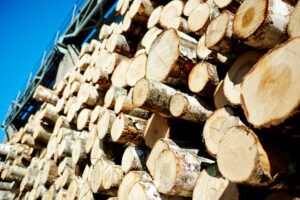Utility poles are the backbone of our power and telecommunications systems.
And depending upon the weather conditions and other factors, we choose certain materials such as wood over others like steel or concrete.
For instance, for Florida, a state frequently hit by hurricanes, we usually recommend using concrete poles. They hold out against the strongest of winds and debris impacts.
However, in the Midwest, where tornadoes are common, wood utility pole is your best choice as they are flexible and can bend easily without breaking under extreme conditions.
But there’s more to it. You must also consider cost, utility pole endurance, environmental impact, and more.
Today, we’ll do a utility pole comparison with wood, aluminum, steel, and concrete poles so you can choose the right one for your project.
Spoiler Alert: Wood utility poles might just be your best bet.
Wood Utility Poles
Those common wood utility poles, most likely made from Southern Yellow Pine or Douglas Fir, have been around for years.
And these are what we use at Gulf South Forest Products too, due to their availability and ease of use.
You can easily notice the rows of wooden poles when you ever drive through a rural area. They’re everywhere for a reason.
The University of Minnesota reports that the United States has installed a staggering 135 million wood utility poles. This sheer number speaks volumes about their reliability.
Additionally, a recent 2024 report by Fortune Business Insights shows that wood utility poles dominate the market. This is because many companies, including us, are leaning towards green technologies such as wood, which contribute to a reduced carbon footprint.
And you know what? The wood used in utility poles is actually renewable and the waste rate is comparatively low.
The strength of wood utility poles shouldn’t be ignored either.
It’s proven to work better than other materials during natural disasters like high winds and thunderstorms. They reduce power arcing and are easier to access for repairs as well.
Aluminum Utility Poles
Aluminum poles are usually reserved for lighting applications. They are lightweight, corrosion-resistant, and weatherproof which makes them ideal for streetlights or parking lot lighting.
However, there are some challenges associated with aluminum utility poles for their application in power transmission lines.
Firstly, aluminum is much more expensive than other utility pole materials. Secondly, they’re more prone to dents and bends, even from minor bumps. So, you’ll need to replace it more often.
Finally, their strength limits them from carrying heavy electrical loads.
Steel Utility Poles
Steel poles are known for their longevity and strength. Although they weigh less than wood utility poles, they can still handle high loads and are often used in urban settings or regions with heavy traffic and dense populations.
But, they require regular maintenance to prevent rust, which can be a significant ongoing expense.
Concrete Utility Poles
Concrete poles stand up well to environmental stress and are mostly famous for their high-temperature resistance and durability. They are recently becoming more popular in modern infrastructure.
Concrete poles are also fire resistant, which can be a crucial factor in areas where there is the possibility of wildfires.
However, they can be heavy and might crack sometimes.
Cost Analysis
We are dividing the cost analysis by initial costs and utility pole installation costs.
Initial costs can be a major deciding factor, especially for large projects. And for those, wood poles come out cheapest without compromising on performance.
Steel is more expensive, while concrete is the priciest. This is due to their high production and transportation charges.
When it comes to utility pole installation costs, again, wood remains your best bet.
They are lightweight and easy to install, which keeps labor fees low. They do require frequent replacement and maintenance, but all things counted, we’d say they are still far less expensive than other utility pole materials.
Like wood, steel can be easy and affordable to install. On the other hand, concrete utility poles are exuberantly heavy and require more effort and equipment.
Utility Pole Durability and Lifespan
Wood Utility Poles
Wood utility poles can last 30 to 40 years. However, over time, they can rot or attract insects.
To help with that, after cutting, wood poles undergo the procedure of “seasoning” such as Chromated Copper Arsenate (CCA) or other surface treatments like Creosote, Penta Copper Naphthenate.
These treatments decrease the chances of wood rot and termite damage and extend the life of wood poles.
Again, if you’re looking for a balance between cost and toughness, wooden utility poles stand out as your only choice in this case.
Steel Utility Poles
Steel poles are strong and are highly resistant to fire, termites, and rust.
But if not taken care of properly, they can wear out pretty quickly. Plus, the cost and effort of regular maintenance might outweigh their benefits.
That said, good quality steel poles can last over an extended period of 40 years with different treatments, coatings, and protection.
Concrete Utility Poles
Concrete poles can last a lifetime — over 50 years easily. Like steel, concrete is also resistant to fire and termites. But corrosion is not an issue with these.
People often choose concrete for their utility pole projects as it’s the strongest option of the two materials.
However, they can crack and require maintenance.
Environmental Impact
Wood Utility Poles
Wood is a renewable resource, especially when harvested sustainably. Sustainable forestry practices can mitigate environmental impact, making wood poles an eco-friendly choice.
Steel Utility Poles
Steel production has some serious environmental impact, but steel is also recyclable. Steel’s recyclability is a plus, but its production process is far from green.
Concrete Utility Poles
Concrete production is resource-heavy and less recyclable. They are durable but come with a high environmental cost.
Performance in Different Conditions
Wood poles, with proper treatment, can withstand many weather conditions. It easily stands up to high winds and is great for dry areas. Plus, it’s an insulator, so perfectly safe when there is heavy rain or thunderstorms.
On the other hand, steel strength is good for city-based areas. To prevent corrosion, we often galvanize the poles. However, they are not the best candidates for placement near the ocean or areas where salting snow is required.
Concrete handles weather really well, especially in seaside areas where wood and steel poles are not helpful. However, it’s heavy and can crack.
Utility Pole Maintenance and Repair
Wood poles require regular treatment and periodic inspections, which are straightforward tasks. Rust prevention is necessary for steel, while concrete requires regular checks for cracks.
Wood poles can be quickly and easily repaired, so the downtime is also low.
Steel repairs are more complex but manageable, and concrete repairs are difficult and expensive, often requiring considerable time and rates.
Conclusion
After considering all factors, wood utility poles emerge as the top choice. They are cost-effective, relatively easy to maintain, and environmentally friendly when sourced sustainably.
While steel and concrete each have their strengths, wood utility poles provide a balanced, reliable option for many applications. They offer a perfect blend of affordability, durability, and environmental responsibility.
If you need utility poles, consider wood for its numerous benefits. Get a free quote here or contact us today to learn more about our wood utility poles and get a quote tailored to your needs.





